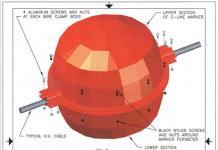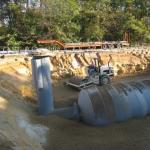Leaking water from the tank into the toilet can become a big problem because the flow of cold water increases greatly. This also leads to the appearance of limescale in the drain bowl. The drain tank has a simple design and repairing it will not be difficult, even for inexperienced users. Most of the materials installed inside are made of plastic, which greatly reduces their service life and leads to constant breakdowns. But how to fix a toilet in a short time if water is leaking?
Frequent problems due to which water constantly leaks from the drain tank
Faults that cause water to leak:
- Water flows non-stop from the water supply pipe.
- Water flows in a small stream into the drain bowl.
- Draining from the tank occurs only after much torment with a lever or button.
- The lever or button does not respond at all.
- Leaks and puddles form near the toilet.
- The tank is filling with an unusual loud noise.
Causes of water leakage in a small stream
Tank is faulty:
- Overflow. The water supply should stop at a certain time (when the float is raised 2.5 cm below the pipe), but there are a number of reasons why this does not happen: the gasket in the tap is deformed; the gasket is not pressed well; the pin is rusted or deteriorated; The valve inside the tank is cracked.
- The lever moved out of place and the toilet began to leak.
- A rusty steel bolt or a cracked plastic bolt.
- Hardening of the rubber of the pear (when the rod is raised, the pear also rises; if the rubber hardens, the pear does not take the desired shape and does not sit correctly in place).
- If the plumbing is new, then a leak is possible due to improper assembly.
- Malfunction in the cuff (water flows between the tank and the bowl).
- Weak fastening of bolts and nuts (connection of the tank to the toilet shelf).
Also read our article, which will tell you in detail.
Drain bowl malfunction a rare occurrence, the main reason for this can be attributed to improper fastening of the toilet to the floor or wall.
Read also the material that will tell you what to do if.
If all the fastenings were made correctly, all the bolts are straight and well tightened, there are no cracks or backlashes, then most likely the problem lies in the tank.
Repairing and stopping leaks - how to fix and eliminate if water runs in the toilet

What to do if a malfunction is detected? First you need to inspect the float for any malfunctions. If the float lever is skewed, water will not linger in the tank (it will accumulate, overflow and immediately flow out). If distortions and leaks are detected, you should open the lid and simply adjust the lever: install it horizontally, 2.5 cm lower from the entrance of the pipe to the tank.
The float itself should be level and empty. There shouldn't be any water inside. If water is detected inside the float:
- Take it out and drain the water.
- Remove the hole through which water enters (heat the plastic or wrap the float in a plastic bag).
- Attach the float back and watch it (if water gets inside).
Such measures are temporary. At the first opportunity, you should buy and install a new float.
Draining water after repeated actions with a lever or button indicates a malfunction of the siphon membrane. The following steps will help fix this:
- We install the crossbar in place of the cover.
- The float lever must be secured to the crossbar.
- Completely empty the tank.
- A nut connects the tank to the flush tube; it needs to be unscrewed.
- Carefully loosen the siphon nut and remove it.
- The faulty membrane should be removed and a new one installed in its place (remember that they differ in diameter and size!)
- Reassemble all parts of the tank in reverse order.
A non-responsive flush button indicates damage to the draft. To repair, it is necessary to remove the faulty rod and replace it with a new one (in extreme cases, replacement with a piece of thick wire is possible).
To prevent the noisy intake of water from disturbing you, you can make a special muffler:

- Prepare a flexible or plastic tube.
- It should be installed in the tank in a vertical position, relative to the level. It should be located near the entrance to the float valve.
- Make sure that the lower end of the tube is covered with water.
If even the installed muffler does not save you from noise, this indicates the need to install a stabilizing float valve. Such a valve will regulate the level of water flow.
Valve installation mechanism to fix leakage
- Empty the tank.
- Disconnect the float valve from the pipe.
- Release the float valve.
- Unscrew the nuts that secure the lever and remove the valve.
- Install and secure the new valve with fixing nuts.
- Reattach the float lever.
- Fill the tank with water and install the lever at a distance of 2.5 cm from the water pipe.
In other cases, the entire water drainage mechanism should be replaced.
Water leaking at the bottom (where it connects to the toilet) indicates damage to the gasket. This seal is located where the tank is attached to the toilet bowl. Replacing the gasket requires completely removing the tank:

- Turn off the cold water tap and drain all the water from the tank.
- Remove the top cover and locate the two bolts at the bottom of the tank (the nuts are on the opposite side). Unscrew the bolts and pull them out.
- Remove the tank and remove the damaged gasket, replace it with a new one.
- Reassemble the tank in reverse order.
If, after removing the tank, it turns out that the gasket is not damaged (and not pressed through), this may indicate that the tank is poorly attached to the toilet. After assembly, it is necessary to tighten the nuts on the bolts(on the back of the tank). If the problem persists, you may need to use a special clamp to fix it. When tightening bolts, you must avoid severe distortions and the application of great force.
When carrying out any repairs to the drain tank, it is necessary to clean the rust and remove dirt and dust from the places where the bolts and gaskets are attached. How to repair the tank is shown in the video:
What to do to prevent the tank from overfilling and stop leaking
What to do if you want to prevent the problem from occurring? The following factors need to be kept in mind:
- Installation of the device is best left to professionals. They will install the toilet correctly and secure all the bolts straight, without bevels or stripping the threads.
- Do not apply strong pressure, displace or loosen it.
- Handle the lever and drain button carefully: do not pull, bend, or hit (this can lead to internal damage).
- Resolve minor problems that arise in a timely manner.
- Replace consumables (bolts and nuts, gaskets, float, bulb and other mechanisms) in a timely manner.
- Adjust the water supply to the tank (so that it is not excessive).
- Monitor changes in the tank and under the toilet lid (water deposits; increased cold water bills; the appearance of drops or condensation on the tank and near the toilet; other similar problems).
Repairing a leak in the cistern is quite doable. Most breakdowns occur with the internal mechanism of the tank.

The diagram shows the internal mechanism of the tank
Replacing any part occurs intuitively, because all components are visible and can be easily unscrewed and removed.
During repairs, it is necessary to shut off the water supply! If the essence of the problem is not clear or fixing it is impossible for you, you should immediately call a plumber. He will quickly identify the breakdown and fix it.
To know what to do if the toilet tank is leaking, you need to determine the causes of the leak.
The first and most common cause of leakage is a loose fit of the pear, the walls of which have lost their elasticity. In this case, it is enough to simply replace the pear with a new one.
The second reason is corrosion of the seat, as a result of which the bulb does not fit completely.
Repair:
remove the pear
check and tighten all screws and fastenings of the lever,
remove corrosion with sandpaper.
A third reason could be poor float valve adjustment.
Repair: replace the gasket in the float valve if it is worn out, or bend the float lever.
The fourth reason could be a loose nut that secures the overflow base.
You need to remove the tank and just tighten it. If the nut is “stuck” to the tank, you just need to turn it 2-3 turns, clockwise.
If it leaks from under the cuff that connects the flush tank and the neck of the toilet, which is visible when flushing the water.
The repair is very simple - pull the cuff into place; for greater effect, you can tighten it with a clamp. If the cuff is worn out, it must be replaced with a new one.
Water may leak where the flexible hose is attached to the tank; this is a signal that the union nut (plastic) has burst.
Repair: it is better to replace the hose with one that is secured with a metal nut.
Fixing toilet leaks
Any plumbing equipment can fail, creating a lot of inconvenience for us. At the same time, it is very important to quickly navigate, find the cause of the breakdown and urgently eliminate it.
What could be the cause and how to quickly eliminate toilet leaks?
There are 3 main reasons for a leaking toilet:
1. Malfunction of the water supply fittings in the toilet
2. Malfunction of the toilet flush fittings
3. Drying of rubber gaskets
If a leak occurs, first try tightening the bolts, just don’t overdo it! The earthenware cistern or the toilet itself may crack. If tightening the bolts does not give a positive result, the following actions should be taken:
Shut off the water supply to the toilet tank.
Flush the toilet tank. Wipe the inside of the tank dry.
Unscrew the nut of the water supply pipe that secures it to the float valve.
Remove all washers and bolts that are on them.
Unscrew the nut securing the flush valve and remove the drain. If the flush valve seat is worn, it should be replaced. You also need to replace the old gaskets.
Place new gaskets inside the tank and insert the flush valve seat through them. Next, you need to screw the flush mounting nut under the tank.
Replace a worn out large toilet gasket.
Place the tank in its place and install the bolts with new gaskets. Tighten the bolts.
Connect the water supply pipe and check the assembly for leaks.
How to disassemble a toilet cistern
Sometimes the toilet causes a lot of trouble. You can deal with minor problems yourself without calling a plumber. To do this, below are recommendations on how to disassemble the toilet tank.
First, you need to turn off the valve on the pipe through which water flows to the toilet. Drain the water from the tank.
Then you need to carefully, so as not to break it, remove the tank lid and inspect the tank from the inside. Typically, the internal mechanism includes two devices. The first is a float mechanism and a fill valve, thanks to which the tank is filled with water and the water is shut off when it reaches a specific level. The second device is a drain mechanism that functions when draining water.
To remove the fill valve that fills the cavity, you need to unscrew the nuts with pliers or a wrench: on the hose that supplies water to the tank and on the wall of the tank, which secures the mechanism itself.
The drain mechanism should be carefully removed so as not to disturb its base. The upper part of the mechanism must be turned to the left and removed from the glass.
If the tank needs to be removed entirely from the toilet, then you should unscrew the fastening between the bowl and the tank.
Reassemble the tank in reverse order.
Toilet cistern design
It is not without reason that owners of plumbing fixtures are interested in the design of the toilet cistern. After serving for a couple of years, and sometimes immediately after installation, the tank can begin to present “surprises”. And of course, I want to look inside and find out what is the cause of the malfunction.
First of all, it should be said that drain tanks are different, depending on the manufacturer. But its fundamental mechanisms are filling and draining.
The filling mechanism provides for filling the tank with water when it is empty. The water level is regulated by a float, which can be easily set to the required level. And the shut-off mechanism closes the water inlet valve when it has reached the required level. When the water drains, the float moves down and the valve opens, allowing the tank to fill. The drain mechanism lifts the siphon, thereby opening access to water. The drain siphon resembles a plunger in appearance and its function is to ensure the tightness of the drain hole. And of course, each tank is equipped with a button that activates the drain mechanism.
Another article
Why is the toilet tank leaking?
2. The bowl of the tank (float) is not adjusted, and water flows through the overflow.
3. When flushing, water flows between the tank and the toilet platform
4. Leak at the hose connection and the valve ball
5. Water flows from under the bolts securing the tank to the toilet platform
I have described the most common causes of toilet cistern leakage, and now I will write how to eliminate them.
Toilet cistern repair. Passes a pear or petal
Let's look at the first reason. We disassemble the toilet cistern: Remove the top cover of the cistern. It is necessary to inspect the pear 
or petal.
Over time they may become deformed or develop build-up, first try wiping them with a rag to keep them clean, and also wipe the saddle to ensure a perfect fit. If it doesn’t help, then you need to buy a new pear or petal and replace it.
The tank valve ball (float) is not adjusted and water flows through the overflow.
We also remove the top cover, and if water flows through the overflow, try to adjust it. If the ball valve is in a tank with a float, 
Then try bending the float lever. There are times when water gets into the float, then you need to remove the float, pour water out of it, and put it back on, and find out the reason for its leakage, and fix it; if the float is defective, then replace it with a new one. It may also not shut off the water due to wear of the rubber inside the faucet ball, try to pull it out and turn it over, or cut out another one if possible, or even replace the faucet ball with a new one.
If the ball crane is like this, 
their models are slightly different from each other, but the principle is the same, then lower the float lower with the adjusting plastic pin. If this does not help, then replace it, or try to disassemble and clean it.



Possible malfunctions: wear of the rubber inside the valve ball - pull it out and insert it the other way, or scale has gotten into the valve ball, disassemble it and carefully remove it with a needle.
The design of the drain tank may differ slightly, but the circuit is the same.
When flushing, water flows between the cistern and the toilet platform
Try tightening the bolts that secure the tank to the toilet. There are defects in casting, then try to coat the cuffs with sealant. When tightening the bolts, do not overdo it, as the toilet platform for the tank may burst.
Leak at the hose connection and valve ball
It's quite simple here. Tighten the hose nut, or if the gasket has become unusable, unscrew the hose and replace it, and screw the hose back on.
Water flows from under the bolts securing the tank to the toilet platform
Try tightening the bolts a little with the nuts, again, if that doesn’t help, then unscrew them, coat the rubber gaskets that are in the tank with sealant, for such connections I use transparent plumbing sealant, and screw them back in.
Here I have described several reasons why a toilet tank is leaking and how to repair a toilet tank yourself. Read also: How to install a toilet on tiles, toilet installation.
It’s unpleasant when such a “stronghold” of a comfortable life as a toilet begins to behave inappropriately, regardless of the nature of the problem: whether the toilet is clogged or leaking. But since both topics are quite significant, it is necessary to choose one, which will be discussed in the article. And here you can find information about toilet leaks, the reasons for this condition and options for fixing and repairing its components with your own hands so that it does not leak after flushing. Quite a large number of problems that arise are typical; the features of their repair are simple and can be implemented even by non-professionals. Also, before reading the article, I can recommend watching the video:
Brief overview of possible problems
Often, problems with drainage begin due to a failure of one part of the toilet. You can solve the problem with a DIY repair, for some you don’t even need tools, but this note applies to small problems in which you need to replace a small plastic part or something like that.
Problems with the toilet when it leaks after flushing can be as follows:
- Continuous supply of water from the water supply to the toilet barrel;
- Water leaking from the tank into the toilet;
- Draining water due to a problem with the float valve;
- Failure of the float valve.
- Failure or gradual wear of one of the many parts.

Tank malfunctions
The most popular problem that requires repairs. Fortunately, during renovations you can almost always do everything yourself. You need to remove the cover and lift the floating lever. Find a rod attached to a ball that floats on the surface and which should control the flow of water from the pipe to the toilet. The rod is called a floating lever. Raise it - and if the water stops flowing, then this means that the problem is that the water “does not rise” to a sufficient height, and the mechanical system “receives” signals that more water is needed. Water may not be collected due to mechanical damage to plastic/rubber/ceramic parts. Therefore, the easiest solution during DIY repairs is to check all components for damage.

When looking for possible problems during DIY repairs, you should check the operation of the floating lever for accuracy of location. It can bend in such a way that the ball catches on the ball arm or side of the reservoir. To check this version, you should flush the water and see with your own eyes whether the version is correct. If the ball really clings, then it is enough to bend the lever with your own hands so that when water is drawn in, the ball freely rises up to the required level.

When using the ball for a long time or using low-quality parts, water may get inside, which makes it heavier and prevents it from performing its full functionality. In this case, it must be disconnected from the lever in a circular motion counterclockwise, drain the water and screw it back. Before screwing it onto the lever, inspect for cracks or other mechanical damage. If they are present, the ball cannot be repaired with your own hands and you must purchase a new one, since repairing the old one is unsuccessful.

It may also happen during a DIY repair that neither raising the lever nor adjusting and adjusting the floating lever gave the desired effect and the water continues to flow. Then there may be another option in the tank - the problem is created by the reinforcing valve used to create a seal at the bottom of the tank. In this case, the sequence of actions will look like this:
- It is necessary to flush the water from the toilet and turn off its supply.
- Check the damper for debris or signs of corrosion. If debris is found, everything must be cleaned out; bottlenecks can be cleared using a pocket knife. In case of corrosion, all traces of it must be removed. After cleaning, you should see if the valve can close everything tightly.
- If water is still flowing, you should inspect the ribbon wire connected to the toilet handle. The wire should line up and allow the flap to fall freely and close the hole. If everything is not as it should be, then the ribbon wire should be bent with your own hands to the required position so that everything closes.
- If water is still flowing, the float valve should be replaced.

Float valve malfunctions
To repair toilets yourself, plastic or metal float valves are used. Replacing plastic taps during DIY repairs is simpler than replacing metal ones:
- Turn off the water supply and empty the tank.
- Unscrew the float valve.
- Install a new plastic float valve.

Replacing a metal tap during DIY repairs takes longer due to the use of metal parts to fix it:
- Empty the tank of water and turn off its supply.
- Unscrew the couple of screws that hold the valve and inspect them. If the screws are old, worn, or simply damaged and may be leaking water, then replacing them will be necessary to fix the problem.
- To replace the float valve itself, you need to unscrew the lock nut, both inside and outside the tank. When installing the float valve, care should be taken to ensure that the operation of all other parts is not disrupted and that nothing moves.

Problems with filling and other causes of leakage
A malfunction can occur when too much water is supplied to the toilet, significantly more than it should accept. Fortunately, this problem can be solved by repairing it yourself. There are usually 4 main problems to blame for overwatering:
- Operation of a floating lever.
- Drain valve operation.
- Operation of water ports.
- Leaking hinge connecting the tank to the toilet.

Correcting the operation of the floating lever has already been discussed above, we can only add: when repairing it yourself, it should be corrected until the water reaches the optimal level. After bending the lever, you should always check how water is drawn in and whether the problem has been corrected and, accordingly, whether the repair can be completed.

When checking a toilet or doing a DIY repair, you should pay attention to whether the flush valve closes completely when the toilet itself is in use. You can configure it so that it works correctly with your own hands. To do this, adjust the floating lever or chain during repairs. Typically, a toilet can be configured to operate the flush valve in three or four ways, so you should try different variations of the settings as you repair until the valve works as it should, completely closing the toilet opening after use. This is due to the fact that universal flush systems are developed for various models, and are adjusted separately for each toilet. But over time, the valves may move a little and need to be adjusted back into place.

Pay attention to the toilet water ports on the bottom of the toilet rim as well. Rust and corrosion processes negatively affect their ability to pass or retain water. You can check their condition using a mirror. If you see that they are damaged, they should be replaced or cleaned so that the toilet ports can work properly. Due to the design features of various products, there is no universal recipe for replacement, but you can try to clean out the rust and hope that removing it will be enough for the ports to start working properly. For cleaning, you should use a brush and appropriate products, and to reach the necessary places, you can use the wiring wound around the brush.
 How to properly install a toilet with your own hands
How to properly install a toilet with your own hands
There are several reasons for malfunctions of the toilet flush system, let's look at the main ones:
Water flows through the overflow
The tank overflows with water and it simply comes out through the overflow. Why does the tank overflow with water: the gasket in the valve is deformed:
installation of a toilet flush fitting of a new design:
- the weak point of this design is the membrane gasket that blocks the water; a small piece of rust can cause a leak through the overflow;
- Over time, the rubber part lost its elasticity and stopped tightly covering the water;
- The gasket is not pressed firmly enough:
- the element itself is not broken, it is simply weakly pressed against the hole of the drain valve;
- the pin that holds the float lever located in the valve body is rusted or lost;
- the float lever has moved;
- the valve could simply crack if it is plastic (If the device is made of brass, a similar reason is impossible);

 First of all, disassemble the upper part of the shut-off column in which the membrane gasket is located and remove debris, in 80% of cases the cause is garbage. Wipe the membrane and valve surface with a clean cloth and remove any foreign debris.
First of all, disassemble the upper part of the shut-off column in which the membrane gasket is located and remove debris, in 80% of cases the cause is garbage. Wipe the membrane and valve surface with a clean cloth and remove any foreign debris.
If the water supply system does not have a coarse filter (mesh), be sure to install it, this will help avoid recurrence of the problem.

The most common problem is a misaligned lever. To correct this situation, it is enough to return the lever to its place: it should lie horizontally, lower than the pipe inlet. To eliminate a continuous leak from the overflow: Remove the top cap of the overflow tank. Raise the float one centimeter: if the leak has stopped and you didn’t need much effort to do it, your search is over. Turn the float lever a little so that it closes the water earlier. If water continues to flow when you raise the float, you most likely need to pay attention to the valve. The design of the valve itself has a pin that secures the lever; make sure that it is intact and intact. A damaged pin can be replaced with a piece of copper wire. Also, there should be no holes in the place where the stud is attached. If it does exist, you will have to buy a new valve.
Be sure to take the faulty part of the mechanism with you or take a photo of the faulty part.

If water constantly flows despite the gasket being tightly pressed to the valve hole, the problem can only be solved by purchasing a new drain mechanism. We looked at an example of a classic (Soviet) toilet, but if you have a modern device, look for the origins of the problems and their solutions by studying your toilet model individually.
If the plumbing is new, leaks may be caused by improper installation.
 The water begins to flow before it reaches the overflow. Water constantly flows, regardless of whether the overflow level has been reached or not. Why is water leaking: the bolt that holds the toilet and shelf together is rusted (if it is steel) or cracked (if it is plastic). Remedy: Make sure water flows only to the overflow level. Turn off the water and flush the tank. Dismantle the flexible line coming from the tank. Remove the bolts that secure the shelf to the toilet. Inspect the fittings: if they are in good condition, it is enough to replace just a couple of bolts, or buy a new set of fittings. Rusty bolts need to be cut off with a hacksaw. Remove the shelf from the cuff, drain the remaining water and place the mechanism on a flat surface. Reassemble the tank with new bolts, preferably brass. Repeat all steps in reverse order. Experts recommend replacing the rubber gaskets in any case. If necessary, tighten the cuff with an aluminum tie or copper wire.
The water begins to flow before it reaches the overflow. Water constantly flows, regardless of whether the overflow level has been reached or not. Why is water leaking: the bolt that holds the toilet and shelf together is rusted (if it is steel) or cracked (if it is plastic). Remedy: Make sure water flows only to the overflow level. Turn off the water and flush the tank. Dismantle the flexible line coming from the tank. Remove the bolts that secure the shelf to the toilet. Inspect the fittings: if they are in good condition, it is enough to replace just a couple of bolts, or buy a new set of fittings. Rusty bolts need to be cut off with a hacksaw. Remove the shelf from the cuff, drain the remaining water and place the mechanism on a flat surface. Reassemble the tank with new bolts, preferably brass. Repeat all steps in reverse order. Experts recommend replacing the rubber gaskets in any case. If necessary, tighten the cuff with an aluminum tie or copper wire.
Water leaks between the toilet bowl and the cistern

1) the problem can be solved easily: just tighten or simply correct the part. Causes of the problem: a faulty cuff is most often the cause of water leakage. Regardless of what material the cuff is made of, there are clamps for both plastic and metal. Tighten the cuff with clamps carefully, not too tight, but not too loose. If the cuff device is corrugated, then it can simply move. In this case, simply return the part to its place and secure it.
2) Replacement of rubber gaskets, tightening of bolts and nuts. Causes of the problem: too weak fixation of the shelf to the tank. Just tighten the fastenings. Metal bolts rust and become deformed over time, but this does not happen to brass bolts. If tightening the bolts and nuts does not help, check the rubber gaskets. They need to either be completely replaced or repaired (dry, apply sealant, dry and reinstall with bolts).
3) Replacing the drain tank. Cause of the problem: Water leaking between the tank and the shelf may be a sign that the shelf is completely broken. This kind of problem is very serious. It is better for you to consult a specialist, because a breakdown often requires a complete replacement of the toilet bowl or even the flush tank. Plumbing products should be regularly inspected for cracks, including the cuff and pipes. toilet design Toilet design for a better understanding of the problem Water flows simultaneously with the flush The essence of the problem: every time you press the flush, water begins to leak from under the tank.
4) Check the serviceability of the drain mechanism inside the tank. Take the valve with your hand and press it lightly. If the leak stops, it means that the reason was hidden in the loose fit of the valve in the center of the tank. In this case, you just need to replace the gasket in the valve. But this reason is far from the only one.
5) The next reason for the tank leaking may be a displaced drain button. If the height adjuster has moved and the valve is higher than the drain hole, then a gap will form between the drain and the shut-off valve. You just need to return the water height regulator to its original position. The breakdown is quite simple and not at all costly.
6) A loose nut on the outside may cause water to leak out. You need to carefully and carefully tighten the nut and also check all the fasteners that secure the flush cistern to the toilet. Minor damage can be repaired and eliminated. The cost of replacing a toilet in Chelyabinsk, in particular here, is not high -
Matvey Kolosov - specialist “HUSBAND FOR AN HOUR”
5 rules before going to the store
There are several rules that I try to adhere to before going to the store for tools or spare parts: 
- 1) — Make a shopping list so that you don’t forget anything and don’t buy too much.
- 2) — Take a photo of the unit being repaired or the assembled spare part, a nameplate with markings if there is one. This makes it easier to explain to the seller, show the photo and he will immediately understand you.
- 3) - Take exact measurements, do not trust “measurements by eye”.
- 4) - Do not buy “for future use”; such purchases usually gather dust in the pantry or garage, and if they break down again, they cannot be found and you have to buy them again.
- 5) - Do not buy used tools or spare parts, no one knows how long they will last and who knows, perhaps the “unheard of cheap” electric drill was stolen. As you know, free is only in a mousetrap.
If you have any doubts or need advice, call us 8922-722-91-00 or ask a question in our group
In this publication we will look at:
There are many reasons why a toilet tank leaks - it could be due to a simple breakdown or simply a negligent attitude towards the duties of the technician who installed the toilet. Somewhere, a screw could have been clamped insufficiently or the rubber gasket was simply installed incorrectly. In general, there are many nuances and one way or another they will have to be eliminated. In this article, together with the website, we will look at the causes and places of the most likely formation of leaks, and also learn how to eliminate them with our own hands.
Repair of toilet cistern photo
The toilet tank is leaking: the reasons why water ends up on the floor
There are two weak points through which liquid can leak out of the toilet tank and cause a lot of trouble for owners and neighbors - it can leak through the gasket installed between the tank and the toilet itself or through the holes for the screws that connect the two parts of the compact. In both cases, the cause is almost always either the design features of the toilet (the tank does not fit tightly onto the bowl and over time it becomes loose, which leads to a leak) or improper installation of the sealing gasket.

The toilet tank is leaking: possible problems
There are other options - for example, a dry gasket included in the kit. By installing it, the master lays a time bomb. But let’s start in order and consider each of the possible places where leaks may occur separately.


Toilet cistern repair photo
These are, in principle, all the places where a leak can occur between the tank and the toilet. As you can see, eliminating it is not so difficult, the main thing is to understand what you are doing. It is for this reason that when repairing a toilet cistern with a button, pay special attention to disassembly - when disassembling something, we study the design and purpose of the device’s parts. This will make it easier to understand the principle of operation of the tank and determine its malfunction.
The video clearly shows how to repair a toilet tank if it is leaking.
Toilet cistern repair: causes of internal leaks and ways to eliminate them
What is meant by internal leakage of the toilet cistern? This is when the water from it does not flow out and onto the floor, but flows into the toilet in a constant trickle or stream. Such a malfunction does not threaten a flood, but it does affect water bills. A trickle of water continuously flowing into the toilet in a month, as a rule, results in cubic meters, which you will have to pay extra for. What to do with such leaks? How to eliminate them?
Here the whole point is in a faulty water supply valve - in the float, or rather in the shut-off mechanism itself. It does not completely shut off the water - this happens in most cases, but sometimes the cause of this phenomenon may be an incorrectly configured overflow pipe of the toilet cistern. Also, such behavior of the shut-off valves of the drain tank can be caused by a malfunction of the drain mechanism itself. Repairing and eliminating these problems needs to start with the simplest thing - by checking the correct adjustment of the overflow tube. Try to raise it a centimeter higher and observe the behavior of the shut-off valves - if the water rises again and flows into the tube, then the problem is in the float valve.

What to do if the toilet cistern is leaking
You need to find the plastic nut, which is located at the base of the float attachment to the toilet tank, and unscrew it - this is where the rubber band responsible for shutting off the water is located. We take it out and rinse it thoroughly under running water. We do the same with the part of the float where it stood - we remove all the debris from there. After that, put the elastic band back in place and tighten everything as it was. It should help - if not, you will have to buy a new rubber band and install it in place of the old one.

Repair of a toilet cistern with photo button
And the third reason why the tank can constantly leak water into the toilet is due to incontinence of the flush mechanism. Simply put, the drain valve does not close completely. The reason may be hidden either in the debris that has gotten under the valve, or in the valve itself, which over time, like all rubber, dries out and no longer fits tightly to the drain hole. In the first case, the edges of the drain hole will have to be thoroughly cleaned, and in the second, the valve rubber will have to be replaced.
In conclusion, I would like to remind you that after repairing the shut-off valves of the toilet, it will not be amiss to perform a high-quality adjustment of the float and overflow - only by establishing their coordinated work, you can sleep peacefully and no longer wonder why the toilet tank is leaking?




















